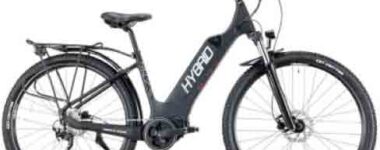Latest News
Share this post:
What goes up must come down. And if you’re on a bicycle, that can be an experience that will make your adrenal glands stand up and say, “Hello!” It is, in fact, what most cyclists live for. Here are some techniques to help you get down the hill—not only intact, but also with style and grace.
Mountain Bike
It’s rocky, rutted and radically steep. It looks like a killer slope. Yet if you can manage to hike down that slope, you can certainly ride down it.
Crazy, perhaps, but true.
Your Tyres
If you can think of your bike’s wheels as you would a shoe, then you can begin to understand the concept of descending on a bike. As your foot goes through its motion while walking normally on a flat surface, your heel hits the ground, absorbing shock. The rest of your foot follows. The arch flexes, you roll forward on the ball of your foot and your toes push off for the next step. Walking is essentially a controlled fall. Going downhill on a bike is much the same—a controlled fall.
As you hike down a slope, the dynamics of your footfall stay much the same. The part of your leg doing most of the work is your quads. As your knee bends, your quads perform an action called eccentric controlled lowering. They are, essentially, your brakes. The wheel, like the foot, keeps rolling along. Your brakes control the rate at which they roll. And, unless you allow your tires to skid (and there’s rarely an excuse for that—it can ruin your control), your wheel will cause no more damage to the trail than your shoes.
Your Brakes
Excellent braking skills contribute to a fluid descent. It’s true the front brake has more stopping power, and because of that fact, it can also throw you over the handlebars if applied too firmly. As long as you are in the correct body position (see the next paragraph for details), however, you can and should apply both brakes evenly.
Your Balance
Since a bike tends toward forward motion on a decline (pesky gravity!), it naturally wants to take you along with it. It is important, then, to adopt a practice of “gentle resistance.” You want to oppose the bike’s desire to fling you over the handlebars, but not in a way that impedes your progress.
Weight Back, Move Forward: As you move down the slope, keep your rear end as far back on the saddle as seems wise without losing control of the bike. If the front end seems wobbly, or skips from side to side, you are probably playing it too safe—leaning too far back. This is more apparent on bikes with front suspensions. They require more give and take. Adjust accordingly by the feel.
Stay Low: Hold your body as close to the bike as possible. Hanging limbs create ungainly movements. Suspension systems may take the jolt out of many rough descents, but your legs and arms are the most effective shock absorbers you have. Keep your elbows bent at an angle slightly greater than 90 degrees and avoid gripping the handlebars too tightly. Relaxing your muscles is the key to manoeuverability. How can you tell if you’re gripping the handle too tightly? Drum the handlebar with your fingers. If you find it difficult, you’re holding on too tightly.
Even if you have suspension, you want your legs relaxed and ready to take bumps. On a hardtail bike this is even more important. To soak up the bumps, get your weight back, grip the seat with your thighs and keep your knees bent and relaxed.
Maintain Your Platform: Your feet should be at 3 and 9 o’clock position. This is called the platform and is the best position for your feet unless you are negotiating tight corners. From this position you are centred on your bike and well balanced. Reacting from this position is a simple process of shifting your weight forward, back, or side to side.
Fluid Descending: Your balancing act isn’t the only thing you can do to keep your bike moving down those steep slopes smoothly. The route you choose and your brake control contribute to a fluid descent as well.
Pick a Line: A beginner’s mistake is looking at spots you want to avoid rather than focusing on where you want to go. Pick a path and stick to it. Fix your eyes on your chosen path. Scan ahead for future hazards. Make sure your head is roughly parallel to your top tube, and look ahead. Remember that foresight is the precursor to all maneuvering. Knowing hazards ahead of time can help you adjust your balance.
What hazards should you look for? That depends on your skill level. A log that will stop one cyclist may be a fun bunnyhop for another. Generally, look for loose rocks, deep sand, water, wet roots, logs and other cyclists, hikers, and, yes, fauna—the occasional bear, deer, rodent or snake.
Here’s a proven method for scanning ahead: As you descend, look ahead 15 or 20 feet. Then, move your eyes back towards your tire. Do this up-and-back action and your eyes will take in lots of information.
Control Your Speed: You want to blaze down the trail, feel the wind on your face, get that adrenaline rush. Sure. That’s part of what cycling is all about. But chances are you are not alone on the trail or road. You could run over an unsuspecting hiker or another bicyclist and that would bring your speed reign to an abrupt halt. This doesn’t mean you can’t go fast—it just means you need to learn to control your speed.
Most downhill racers start off going as fast as they can, giving little thought to braking. Then they lose races and are forced to learn what advanced racers know: You can increase your overall speed by using your brakes, maintaining control and utilising the terrain for optimum performance.
The Big Tricks
Did someone mention steep? Descending over boulders or sheer drop-offs is an advanced technique and should be attempted only by experienced riders. If you’re experienced and feeling confident, the same rules apply, except with greater emphasis:
-
-
-
- Lean way back. Brace your belly near to or against the back of the saddle.
- Keep your elbows bent and body low.
- Rely on both brakes, but mostly on your rear brake, as you may need to release the front to provide more momentum.
-
-
Road Bike
The sign warns trucks that there is a 7% grade for the next 8 miles. No problem. You shift into a higher gear, lean into the drops and start pedalling faster. Going downhill on a road bike is a combination of comfort level, knowing what your bike can handle and employing a few standard techniques to keep you safe. Before reading further, make sure you’ve read the information above. Descending on a mountain bike employs much of the same skills you need to descend on a road bike.
Comfort Level and Cycling Ability
Some people get going fast and they tense up; others get going fast and they only want to go faster. It’s a comfort-level thing. Your comfort level is determined somewhat by genetics (some are just wired to go fast), but mostly by practice and confidence. The more sure you feel about your bike and your ability to handle it, the more comfortable you’re going to feel about the speeds you reach as you fly down a hill.
Your Tyres
Traction is generally not an issue when on a road bike. And advances in tires have made them more reliable than ever. However, staying vigilant and scanning the road for debris can help make your ride trouble free. What do you do if you encounter poor traction?
Sand or Gravel: Hit the brakes too hard when you encounter poor traction and you could be unbalanced going through the rough. This can end in a crash. If you determine that you have time to brake, throw your weight back and do so. But make sure your weight comes forward and that your feet are in the platform position when you reach the rough. Make sure your body is ready to absorb shock. Keep a firm but relaxed grip on the bars and don’t touch the brakes once in the area of poor traction. Also, resist the urge to put a foot out for stability. This is a sure way to crash. Think light and imagine floating over the rough. The key is to keep balanced and stable. This will see you safely through. You can scrub speed if you need to after the sand or gravel is safely behind you.
Other Debris: Wires, boxes, soda cans and more: This is the garbage with which road bikes must contend. The best defence is a good offence where road debris is concerned. Keep your eyes scanning ahead and looking for debris. It’s easy, especially on long stretches, to become mesmerised by the speed and the rushing wind. Don’t! However, if you find debris in your path, the best you can do is a slight bunnyhop (if you feel comfortable doing bunnyhops), or to run the debris over. Either way, a relaxed grip and coming up slightly out of the saddle will help. If the debris does cause you to crash, remember to stay loose and roll with the crash. Putting your hands out will cause more harm than good.
Your Brakes
Knowing when not to use the brakes is perhaps the most important thing to know about descending on a road bike. Try to keep your hands off the brakes. Why? Even slight use of the brakes at the inappropriate time can throw off your balance or take you off the line you’ve established. If you do use them, keep the pressure light, move your weight back and apply both brakes evenly.
Your Balance
As with a mountain bike, the steeper the hill, the more your weight should be back on the saddle. Pressure on the rear wheel helps with braking and with cornering. Make sure your grip is relaxed and get into the drops with your hands near the brakes. Flying down a hill is not the proper time to be casually steering your bike from the brake hoods.
When cornering, remember to drive down the outside leg and lean on the inside drop. If you need to throw a knee out, that’s fine, but keep your outside elbow in close and your head and shoulders level. This will help ensure your tires stay in contact with the road.
The Basic Idea
If used in unison, all of these techniques will result in a safer and more enjoyable ride. With practice and development of the proper muscles and reflexes, balance and control become second nature. Then you can concentrate on the simple merits of speed—a good, tasty downhill, the wind rushing through your helmet, the exhilarating blur of scenery.


 Collecting and Propagating Seeds
Collecting and Propagating Seeds China on a Plate: The Flavours of a Nation (with a Spotlight on Sichuan)
China on a Plate: The Flavours of a Nation (with a Spotlight on Sichuan) Kinesiology Cross Patches
Kinesiology Cross Patches Camaraderie On a Walking Tour…
Camaraderie On a Walking Tour… How E-Biking Has Transformed Biking Tours
How E-Biking Has Transformed Biking Tours








